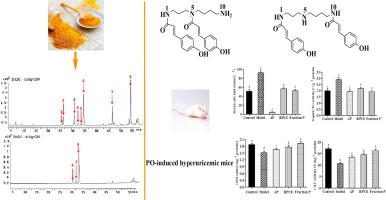Journal of Functional Foods ( IF 3.8 ) Pub Date : 2018-06-02 , DOI: 10.1016/j.jff.2018.05.064 Rui-dan Wang , Guan-hua Su , Lin Wang , Qing Xia , Rui Liu , Qun Lu , Jiu-liang Zhang

|
This study was aimed at evaluating the hypouricemic effect of rape bee pollen from Qinghai province in China. Rape bee pollen crude extracts (RPCE) was obtained by n-butanol extraction and purified by polyamide resin and AB-8 resin respectively to generate five fractions (fraction 1–5). In vitro, fraction 5 had strongest inhibition on xanthine oxidase (XO) (IC50 = 0.21 ± 0.02 mg mL−1) among five fractions and had reversible and mixed inhibitory effect on XO. Fraction 5 was further purified and then generated fraction 5′. In vivo, fraction 5′ had lower serum UA level and could reduce serum BUN, Cr levels and hepatic XO activity more effectively than RPCE in potassium oxonate-induced hyperuricemic mice. Moreover, fraction 5′ had higher CAT activity and content of GSH in hyperuricemic mice. Six compounds including quercetin-3-O-(2″-O-glucopyranosyl)-glucopyranoside (peak 1), quercetin-3-O-(2″-O-glucopyranosyl)-rhamnopyranoside (peak 2), kaempferol-3-O-(2″-O-glucopyranosyl)-glucopyranoside (peak 3) and N′, N″-di-p-coumaroylspermidine (peak 4–6) in RPCE were identified by using HPLC-ESI-QTOF-MS/MS, whereas only peak 4 to 6 were found in fraction 5′. This study shows that rape bee pollen has potential clinical application value as an effective anti-hyperuricemia bioactive drug or functional food.











































 京公网安备 11010802027423号
京公网安备 11010802027423号